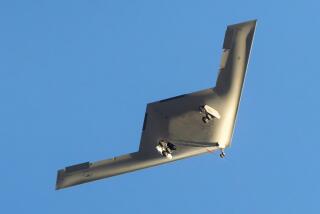Bomber makes test flight using only synthetic fuel
EDWARDS AIR FORCE BASE — A B-52 bomber took off from here Friday with all eight of its engines running on synthetic fuel, the first time that a U.S. military aircraft has flown without the kerosene formula that has been used since the advent of the jets.
The nearly six-hour flight of the lumbering Stratofortress went off without a hitch, Air Force officials said, lifting prospects for the use of alternative fuel by the military and commercial airlines as they grapple with the high price of crude oil.
“So far so good,” said Chris Stroh, the Air Force’s lead engineer on the project, after the B-52 was in the air for about two hours. “We’re seeing very little difference” in the plane’s performance.
Friday’s flight culminated a series of tests that the Air Force has conducted in the last year to gauge whether the new blend could replace the kerosene formula called JP-8.
U.S. airlines have been following the tests closely. Hammered by steep oil prices, the industry considers alternative fuel a key priority, especial if it could be derived from a stable and cheaper domestic source.
Jet fuel jumped from an average of 75 cents a gallon in 2001 to $2.01 last year, though it has moderated in recent months. U.S. airlines spent more than $33 billion on fuel last year and passed the cost on to passengers, some of whom paid as much as $100 more a ticket in fuel surcharges.
With the tests on the B-52 successful, the Air Force plans further testing of synthetic fuel using aerial refueling tankers, which are powered by the same engines as commercial jetliners.
“They would apply nicely to commercial airplanes,” said Lt. Col. Troy Asher, commander of Edwards’ 419th Flight Test Squadron, which is flying the test aircraft. “But right now our objective is to get the fuel qualified as an alternative fuel for the B-52.”
The bomber, the largest in the U.S. arsenal, is a gas guzzler. It requires 47,000 gallons to fill its tanks. With a fleet of such airplanes, the U.S. military is the world’s largest buyer of fuel, consuming 8 billion gallons a year. The Air Force alone spent $5 billion on fuel last year.
The test flights represent what the Pentagon says is a 10-year plan to wean itself from crude oil and foreign petroleum producers who supply about half of the U.S. military’s fuel. The Pentagon hopes that about half its fuel with be synthetic by 2016.
The fuel being tested is a 50-50 blend of traditional crude-oil-based jet fuel and a synthetic liquid, produced by Tulsa, Okla.-based Syntroleum Corp. The liquid is made from natural gas but will eventually be refined from U.S.-produced coal, which is abundant.
The technology to turn coal into liquid fuel was developed in the 1920s by German scientists who sought to make up for scarce oil supplies. The fuel was vital to the German military during World War II.
But the synthetic fuel remained mostly grounded because of the lower cost of crude oil. Air Force officials said the only other time that a U.S. aircraft may have used the fuel was when Air Force One flew to South Africa, where the country used the alternative fuel during an oil embargo.
Air Force pilots began test flights using the fuel in September when they piloted the B-52 with two of its eight engines powered by the blend. The other engines used the traditional JP-8 jet fuel as a test comparison and for safety reasons. A second test flight was conducted with the two engines, giving the Air Force confidence to try flying the B-52 with all of its eight engines entirely powered by the blend.
During Friday’s mission, the B-52 was taken through flying rigors similar to those in a combat sortie, including climbing to 48,000 feet, meeting up with a tanker to simulate an aerial refueling and throttling through various speeds. The plane carried no JP-8 as a backup.
The bomber was piloted by Maj. Gen. Curtis Bedke, commander of the Air Force Flight Center, instead of the usual test pilots. “That’s confidence in the fuel,” Asher said.
Next month, the B-52 is scheduled to go to Minot Air Force Base in North Dakota to participate in tests of how the engines perform with blended fuel in frigid temperatures before the Air Force begins the process of certifying the fuel for use by its entire B-52 fleet.
Stroh said that so far the comparison data show very little difference between the new blend and the traditional jet fuel: “They line up perfectly.”
More to Read
Sign up for Essential California
The most important California stories and recommendations in your inbox every morning.
You may occasionally receive promotional content from the Los Angeles Times.









